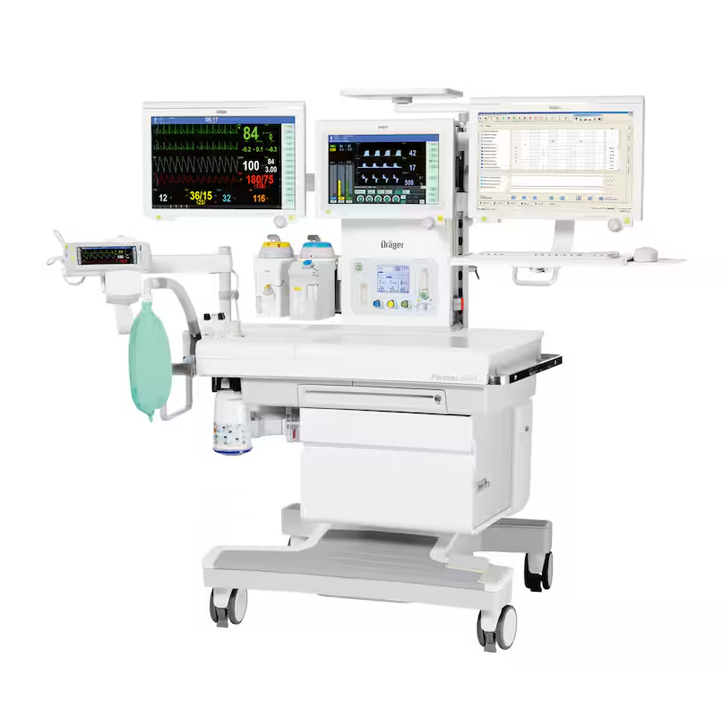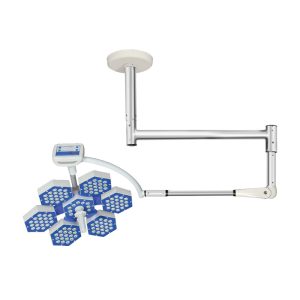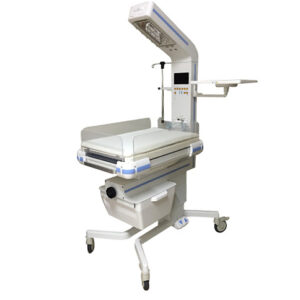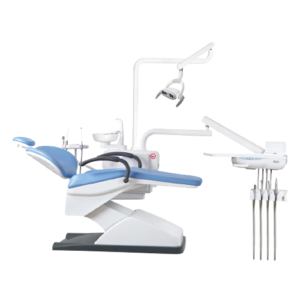Anesthesia Machine Perseus® A500 Specifications
| Weight | Approx. 160 kg (basic setup) |
| Dimensions | (H x W x D) 148 cm x 115 cm x 79 cm (58.3 in x 45.2 in x 31.1 in) |
| Power consumption | 70 W, typical, max. 2.2 kW with auxiliary power outlets in use |
| Mains power supply | 100 – 127 V ~ 50/60 Hz or 220 – 240 V ~ 50/60 Hz |
| Maximum power consumption | 12 A |
| Integrated battery backup time | Min. 30, typically 150 minutes (with new and fully charged batteries) |
| Data interfaces | 2 x RS 232 (MEDIBUS Protocol), 1 x USB, 1 x LAN |
| Integrated power sockets | 4 x country-specific (with isolation transformer) or 4 x IEC |
| Storage surface and drawers | 1 drawer with lock and writing surface (optional) |
| 2 additional drawers (optional), including one with lock | |
| Working surface | Approx. 85 x 35-50 cm (suitable for DIN A3 paper format) |
| Application and ambient conditions | |
| Temperature | 10 to 40 °C (50 to 104 °F) |
| Air pressure | 620 to 1,060 hPa (9.0 to 15.3 psi)
equivalent to 4,000 meter elevation |
| Fresh-gas delivery – electronic mixer | |
| Fresh-gas flow | OFF; 0.2 to 15 L/min |
| Disable O2 concentration | 21 to 100 % in air; 25 to 100 % (in N2 O) |
| O2 flush | 25 to 75 L/min at 2.7 to 6.9 bar gas supply pressure |
| O2 flow for auxiliary and additional oxygen O2 emergency delivery | OFF; 2 to 10 L/min
O2 safety flow is also fed through the Vapor when the device is switched off |
| Breathing system (heated) | |
| Volume | approx. 2.2 L (incl. CO2 absorber) |
| Absorber volume | approx. 1.2 - 1.5 L |
| Reprocessing | cleaning, disinfection and sterilization; replaceable without additional tools |
| Number of individual components during reprocessing | 10 |
| Heated breathing system, exchangeable without additional tools | |
| Ventilator | |
| TurboVent2 Ventilator (electrically driven and electronically controlled turbo ventilator), fresh-gas decoupled, ventilation also possible without any gas supply (driving gas consumption 0 L/min), autoclavable | |
| Standard ventilation modes | Manual/Spontaneous (MAN/SPON) |
| Pressure-controlled: time-cycled (PC-CMV), synchronized (PC-BIPAP) | |
| Volume-controlled: time-cycled (VC-CMV), synchronized (VS-SIMV, time-cycled AutoFlow (VC-CMV/AF, synchronized AutoFlow (VC-SIMV/AF) | |
| Optional ventilation modes | Pressure support ventilation (CPAP/PS), selectable pressure support for volume-controlled ventilation (VC-SIMV/PS), pressure-controlled ventilation (PC-BIPAP/PS), and AutoFlow (VC-SIMV/AF/PS), selectable CPAP for Manual/Spontaneous |
| Airway Pressure Release Ventilation (PC-APRV) | |
| External fresh-gas outlet | |
| Insp./Exp. hold, lung-recruitment maneuver (One-step or Multi-step) | |
| Patient demographics | Neonates, children, adults |
| Tidal volume | 20 to 2000 mL in volume-controlled ventilation |
| 3 to 2500 mL in pressure-controlled ventilation | |
| Inspiratory pressure (Pinsp) | PEEP +3 to 80 hPa (cmH2 O) (3 to 80 hPa (cmH2 O) when PEEP = Off) |
| Pressure limitation (Pmax) | PEEP +7 to 80 hPa (cmH2 O) (7 to 80 hPa (cmH2 O) when PEEP = Off) |
| Pressure support above PEEP (ΔPsupp) | Off, 1 to (80 - PEEP) hPa (cmH2 O) |
| Respiratory rate (RR) | 3 to 100 /min |
| Inspiratory time (Ti) | 0.2 to 10 s |
| Inspiratory flow | 0 to 180 L/min |
| PEEP/CPAP | Off, 2 to 35 hPa (cmH2 O) |
| I:E | 1:50 to 50:1 |
| Triger sensitivity | 0.3 to 15 L/min |
| Measuring systems, displays and other functionalities | |
| 15.3" (38.9 cm) touchscreen, configurable screen contents, smart alarm management with extensive support system | |
| Minute volume (MV) and tidal volume (VT and ΔVT); Respiratory rate (RR); Peak inspiratory pressure (PIP); Plateau pressure (Pplat); Mean airway pressure (Pmean); Positive end-expiratory pressure (PEEP); Compliance; Resistance; MV x CO2 , O2 uptake | |
| Inspiratory and expiratory gas concentration of O2 , N2 O, CO2 and anesthetic agents (automatic identification of halothane, enflurane, isoflurane, sevoflurane, desflurane); Age-corrected xMAC display; Vaporizer setting (optional); Prediction of anesthetic gas concentration (optional); Prediction of inspiratory O2 concentration (optional) | |
| Simultaneous display of 3 or 4 real-time waveforms for: Concentration of CO2 , O2 and anesthetic agents, airway pressure, inspiratory and expiratory flow | |
| Bar diagram display of volume and tidal volume; Virtual flow tubes for O2 , AIR, N2 O | |
| Simultaneous display of 2 loops; Volume-pressure and flow-volume, reference loop | |
| Display of graphical or tabular trends or mini-trends simultaneously with real-time waveforms and volume-pressure loop | |
| Econometer for displaying fresh-gas efficiency (optionally including temporal trend or in the form of low-flow assistant) | |
| Determination of consumption and uptake (determination of uptake only for anesthetics) fresh-gas and anesthetics per case and since last zeroing | |
| AutoSet for alarm limits | |
| Status display for display of airway pressure, supply status of battery and gases (CGS + cylinders) | |
| Dosing of O2 and anesthetic agents during MAN/SPON ventilation possible, even when device is switched off | |
| Programmable, time-based fully automatic start-up and system test of device and software including calibration of all sensors; normally no user action necessary after start of test | |
| Integrated, dimmable illumination of working and documentation surfaces, illuminated vaporizers (optional) | |
| Central brake, smooth running castors with cable detectors | |
| Data storage on USB flash drive (alarm history, system test results, screen shots, trends and machine configurations; optionally: log files) | |






